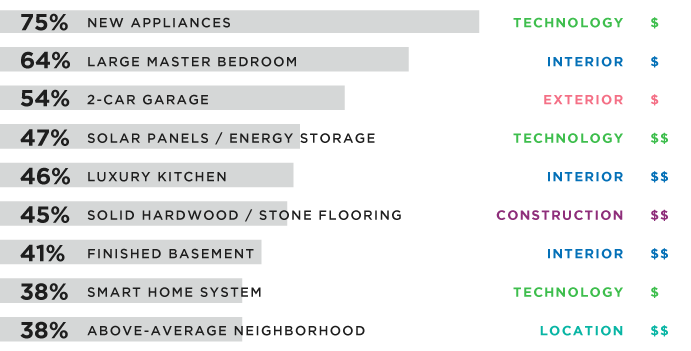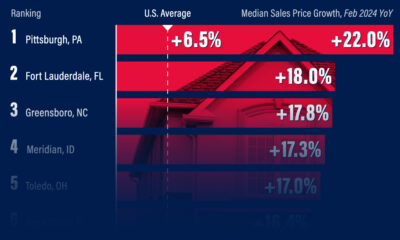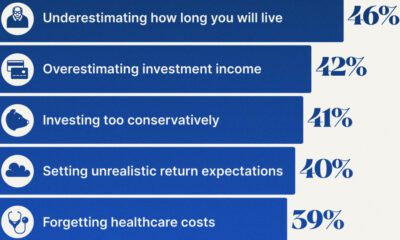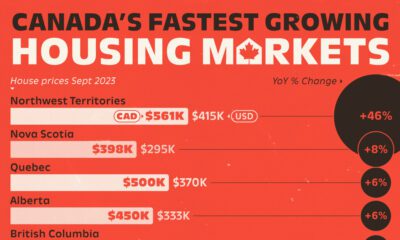Markets
Survey Results: What Do Millennials Want in a Home?
When it comes to buying a home, it’s safe to say that many millennials are caught in a catch-22.
Even though more millennials associate buying a home with the “American Dream” than any other generation, the homeownership rate for Americans under age 35 is near record lows at just 34.7%. In other words, millennials seem to want to buy homes, but various factors have been preventing them in doing so.
Waiting until later in life to start families is one commonly-cited aspect of the story, but millennials are also saddled with student debt and low wages, which have prevented from from amassing any significant savings.
Despite these factors, the demographic evidence is compelling – and many experts are expecting a shift in millennial buying behavior in the coming years.
What Millennials Want in a Home
As the real estate sector becomes more focused on millennials, the market is keying in on an important question: what do millennials want in a home?
Today’s infographic from Northshore Fireplace has an interesting methodology to help us get started in thinking about this question. In late 2016, they commissioned a unique study on 1,000 millennials, representative of all 50 states, in which respondents played a hypothetical game.
Each prospective buyer was put in the following situation: they are starting with an average American home (20+ years old, three bedrooms, and two baths), but have a $300,000 budget to choose between 38 hypothetical property upgrades to get them closer to the home of their dreams.
Here is how millennials chose to spend those budgets:

The results are fascinating, and provide an interesting lens with which to think of real estate in the coming millennial era:
- The three most popular upgrades were also in the lowest cost category: new appliances (75%), large master bedroom (64%), and two-car garage (54%)
- The least popular upgrade was an above-ground pool (3%)
- Having solar power and an energy storage system also ranked relatively high at 47%
- Only 24% respondents cared about upgrading to have more land (1+ acres)
- Other popular options: luxury kitchen (46%), solid hardwood/stone flooring (45%), and finished basement (41%)
Study Methodology
First, a baseline was established to represent the average American home. In this case, it was 20+ years old, and came with three bedrooms and two baths, a one car garage, an unfinished basement, and old appliances. All this sits on a quarter-acre lot in an average neighborhood, as part of an average school district. The approximate value of this home is $200,000.
Respondents were given $300,000 of play money to spend, using a hypothetical menu of 38 upgrades with a combined value of $1,000,000. This was represented on the survey by having 20 points to choose from, with each option costing one to three points (depending on how expensive it is).
Northshore Fireplace also rightly noted that real estate is highly subjective – and although in real life these different costs may vary, what is important in this context is how millennials value things within the vacuum of this game.
Economy
Economic Growth Forecasts for G7 and BRICS Countries in 2024
The IMF has released its economic growth forecasts for 2024. How do the G7 and BRICS countries compare?

G7 & BRICS Real GDP Growth Forecasts for 2024
The International Monetary Fund’s (IMF) has released its real gross domestic product (GDP) growth forecasts for 2024, and while global growth is projected to stay steady at 3.2%, various major nations are seeing declining forecasts.
This chart visualizes the 2024 real GDP growth forecasts using data from the IMF’s 2024 World Economic Outlook for G7 and BRICS member nations along with Saudi Arabia, which is still considering an invitation to join the bloc.
Get the Key Insights of the IMF’s World Economic Outlook
Want a visual breakdown of the insights from the IMF’s 2024 World Economic Outlook report?
This visual is part of a special dispatch of the key takeaways exclusively for VC+ members.
Get the full dispatch of charts by signing up to VC+.
Mixed Economic Growth Prospects for Major Nations in 2024
Economic growth projections by the IMF for major nations are mixed, with the majority of G7 and BRICS countries forecasted to have slower growth in 2024 compared to 2023.
Only three BRICS-invited or member countries, Saudi Arabia, the UAE, and South Africa, have higher projected real GDP growth rates in 2024 than last year.
| Group | Country | Real GDP Growth (2023) | Real GDP Growth (2024P) |
|---|---|---|---|
| G7 | 🇺🇸 U.S. | 2.5% | 2.7% |
| G7 | 🇨🇦 Canada | 1.1% | 1.2% |
| G7 | 🇯🇵 Japan | 1.9% | 0.9% |
| G7 | 🇫🇷 France | 0.9% | 0.7% |
| G7 | 🇮🇹 Italy | 0.9% | 0.7% |
| G7 | 🇬🇧 UK | 0.1% | 0.5% |
| G7 | 🇩🇪 Germany | -0.3% | 0.2% |
| BRICS | 🇮🇳 India | 7.8% | 6.8% |
| BRICS | 🇨🇳 China | 5.2% | 4.6% |
| BRICS | 🇦🇪 UAE | 3.4% | 3.5% |
| BRICS | 🇮🇷 Iran | 4.7% | 3.3% |
| BRICS | 🇷🇺 Russia | 3.6% | 3.2% |
| BRICS | 🇪🇬 Egypt | 3.8% | 3.0% |
| BRICS-invited | 🇸🇦 Saudi Arabia | -0.8% | 2.6% |
| BRICS | 🇧🇷 Brazil | 2.9% | 2.2% |
| BRICS | 🇿🇦 South Africa | 0.6% | 0.9% |
| BRICS | 🇪🇹 Ethiopia | 7.2% | 6.2% |
| 🌍 World | 3.2% | 3.2% |
China and India are forecasted to maintain relatively high growth rates in 2024 at 4.6% and 6.8% respectively, but compared to the previous year, China is growing 0.6 percentage points slower while India is an entire percentage point slower.
On the other hand, four G7 nations are set to grow faster than last year, which includes Germany making its comeback from its negative real GDP growth of -0.3% in 2023.
Faster Growth for BRICS than G7 Nations
Despite mostly lower growth forecasts in 2024 compared to 2023, BRICS nations still have a significantly higher average growth forecast at 3.6% compared to the G7 average of 1%.
While the G7 countries’ combined GDP is around $15 trillion greater than the BRICS nations, with continued higher growth rates and the potential to add more members, BRICS looks likely to overtake the G7 in economic size within two decades.
BRICS Expansion Stutters Before October 2024 Summit
BRICS’ recent expansion has stuttered slightly, as Argentina’s newly-elected president Javier Milei declined its invitation and Saudi Arabia clarified that the country is still considering its invitation and has not joined BRICS yet.
Even with these initial growing pains, South Africa’s Foreign Minister Naledi Pandor told reporters in February that 34 different countries have submitted applications to join the growing BRICS bloc.
Any changes to the group are likely to be announced leading up to or at the 2024 BRICS summit which takes place October 22-24 in Kazan, Russia.
Get the Full Analysis of the IMF’s Outlook on VC+
This visual is part of an exclusive special dispatch for VC+ members which breaks down the key takeaways from the IMF’s 2024 World Economic Outlook.
For the full set of charts and analysis, sign up for VC+.
-

 Markets1 week ago
Markets1 week agoU.S. Debt Interest Payments Reach $1 Trillion
-

 Markets2 weeks ago
Markets2 weeks agoRanked: The Most Valuable Housing Markets in America
-

 Money2 weeks ago
Money2 weeks agoWhich States Have the Highest Minimum Wage in America?
-

 AI2 weeks ago
AI2 weeks agoRanked: Semiconductor Companies by Industry Revenue Share
-

 Markets2 weeks ago
Markets2 weeks agoRanked: The World’s Top Flight Routes, by Revenue
-

 Countries2 weeks ago
Countries2 weeks agoPopulation Projections: The World’s 6 Largest Countries in 2075
-

 Markets2 weeks ago
Markets2 weeks agoThe Top 10 States by Real GDP Growth in 2023
-

 Money2 weeks ago
Money2 weeks agoThe Smallest Gender Wage Gaps in OECD Countries














